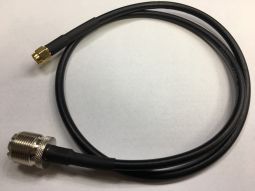We use
cookies and similar technologies
to help give you the best experience on our site and to show you relevant advertising. If you continue to use this site, we’ll assume that you’re happy to receive all cookies
KiwiSDR 2 Latest version. Made in New Zealand
SKU Part Number:
KIWI-SDR-2
£409.99
£341.66
Availability: In stock

Seen this product cheaper elsewhere?
Call 0345 2300 599KiwiSDR 2 Standalone Software Defined HF Receiver
Frequency Range: 0-30MHz
Complete with a BeagleBone Green housed in a durable aluminium enclosure, this unit includes a GPS antenna and a self-test cable, ensuring high performance and reliability.
Plug & Play Ready
No additional computer required. Ships ready with everything you need to start immediately:
- Just plug in a 5V power supply
- Connect an Ethernet cable to your network
- Attach an HF antenna
Once set up, your HF radio will be accessible from anywhere in the world via the Internet.
Power Supply Requirements
Requires: 5V 2A DC supply with a standard 5.5mm round connector and a 2.1mm centre hole.
For optimal performance, a very low noise power supply is necessary. We recommend using Genuine Apple USB iPhone chargers (not supplied) for their reliability and efficiency. Avoid cheap clones to prevent performance issues.
Designed and manufactured in New Zealand
New Kiwi owners:
KiwiSDR 2:
- Unlike KiwiSDR 1 no SD card is supplied. The software is pre-installed and should work out of the box. Also unlike KiwiSDR 1 the first network software update is delayed until the overnight update window (1-5AM local time) so you don't have to wait an extra hour before first use. This assumes the Kiwi has a network connection to the Internet etc.
KiwiSDR 2 runs Debian 11 (Bullseye).
- Every KiwiSDR 2 has the proxy service enabled by default. So you can connect using the serial number, e.g. 21xxx.kiwisdr.com The serial number is found on the printed sheet inside the shipping box. Also written on the bottom of the metal case. On the admin page, connect tab, you may disable this and use whatever connection method you like (e.g. by domain name, IP address, DUC domain etc). You can also change the proxy name from the serial number to a name you choose (assuming it's not already taken).
- Because the proxy URL is available from anywhere on the Internet the admin page (21xxx.kiwisdr.com/admin) must have a default password. This password is written on the printed sheet that is inside the shipping box (four numbers and/or lowercase letters). If necessary email your serial number to [email protected] and we can tell you the password.
As soon as possible please change the admin password on the admin page, security tab.
-
KiwiSDR 2 connectors are reversed compared to KiwiSDR 1Because the Kiwi board is mounted upside down inside the enclosure (to make access to the Beagle SD card slot easier) the RF IN (antenna) and GPS 3.3V SMA connectors are left/right reversed compared to what you might be used to on KiwiSDR 1.
- Customize the details of your Kiwi user interface.
When you connect to the SDR you will note that default values for the name, location and other details are displayed. You can change these by connecting to the admin page (21xxx.kiwisdr.com/admin) and changing the information on the Config and Webpage tabs. If you wish to make your Kiwi publicly accessible then change the settings on the admin Public tab. Changing some of these setting will prompt you to restart.
Shipping:
We have several shipping options for our products, including next-day and Saturday/Sunday delivery for certain items. Please see these options at checkout.
Returns:
If you have any equipment that needs to be returned to Martin Lynch & Sons, please fill out the form below:
Upon receipt of goods you have 14 days to return goods however the goods must be returned in original packaging and care must have been taken with the goods you wish to return. Under distance selling regulations you are not entitled to any refund on carriage charges or modification charges made at your request.
Warranty Terms and Conditions
Outside of the 14 faulty return period, returned items cannot be accepted, unless covered by manufacturer's warranty. We will repair as much as possible on site however in exceptional circumstances products may have to be returned to the manufacturer of distributor.
For repairs/replacements under manufacturer’s warranty for any item please download a ML&S return form from the link above and return to ML&S with the faulty product.
International Warranty information
Warranty service for items we sell is available in the U.K. only, unless otherwise noted. It is your responsibility to pay freight for returned items to the U.K. and back to you for desired warranty coverage. All of our NEW products come with a minimum 12 month warranty, (Yaesu & Icom 24 months), with up to 90 days on second-hand equipment. Items returned for service must state "returned goods for repair" on the return air waybill or U.K. import customs duties apply and will be added to your invoice. For more info about returning items please contact our customer help desk, [email protected]







